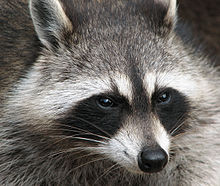Face
- For the novel, see Face (Benjamin Zephaniah). For other uses, see Face (disambiguation).
| face | |
|---|---|
 A human face (Mona Lisa). | |
| Details | |
| Identifiers | |
| Latin | faciesa |
| MeSH | D005145 |
| TA98 | A01.1.00.006 |
| TA2 | 112 |
| FMA | 24728 |
| Anatomical terminology | |

The term face refers to the central sense organ complex, for those animals that have one, normally on the ventral surface of the head and can depending on the definition in the human case, include the hair, forehead, eyebrow, eyes, nose, ears, cheeks, mouth, lips, philtrum, teeth, skin, and chin.[1] The face has uses of expression, appearance, and identity amongst others. [2]
Caricatures
Caricatures often exaggerate facial features to make a face easily recognized in association with a pronounced portion of the face of the individual in question—for example, a caricature of Osama bin Laden might focus on his facial hair and nose; a caricature of George W. Bush might enlarge his ears to the size of an elephant's; a caricature of Jay Leno may pronounce his head and chin; and a caricature of Mick Jagger might enlarge his lips. Exaggeration of memorable features helps people to recognize others when presented in a caricature form. [3]
Individuality and Recognition
The face is the feature which best distinguishes a person, and there are special regions of the human brain which when damaged prevent the recognition of the faces of even intimate family members. The pattern of specific organs such as the eyes or parts thereof are used in biometric identification to uniquely identify individuals.
Metaphor
By extension, anything which is the forward or world facing part of a system which has internal structure is considered its 'face', like the facade of a building. For example a Public Relations or Press Officer might be called the "face" of the organization he or she represents. "Face" also refers to reputation or standing in society, particularly Chinese society and is spoken of as a resource which can be won or lost. Because of the association with individuality the anonymous is sometimes called the "faceless".
Plastic surgery
Cosmetic surgery can be used to alter the appearance of the facial features. [4]. Severely disfigured individuals have recently received full face transplants.
